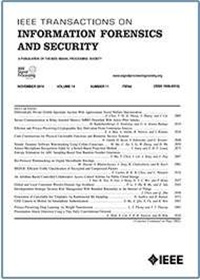GraphBGP:基于动态图学习的BGP异常检测
IF 8
1区 计算机科学
Q1 COMPUTER SCIENCE, THEORY & METHODS
IEEE Transactions on Information Forensics and Security
Pub Date : 2025-09-08
DOI:10.1109/TIFS.2025.3607239
引用次数: 0
摘要
检测异常BGP(边界网关协议)消息对于自治系统(AS)级网络上域间路由系统的安全至关重要。路由策略的动态性、大规模的全局路由和不完整的全局拓扑可见性使得识别BGP异常异常非常困难,更不用说追溯到恶意或错误配置的as了。为了有效克服这些障碍,本文提出了一种新的BGP异常检测方法GraphBGP,该方法动态构建实时as级拓扑,实现精确的异常检测和分类,并准确跟踪恶意或错误配置的as。具体来说,为了解决BGP路由状态的演化特性,GraphBGP构建了一个带有属性的as级图,动态地集成了节点和边缘属性。它可以智能跟踪BGP更新,从而有效地刷新该图。利用这种丰富的、最新的表示,GraphBGP采用基于图卷积网络(GCNs)的定制检测和跟踪模型,实现精确的异常识别和源跟踪。真实世界和合成数据集的综合实验表明,即使在部分BGP网络可见性下,GraphBGP也能实现最先进的异常检测精度,同时显著减少推理时间。此外,在检测到异常后,GraphBGP可以在7毫秒的短时间内精确跟踪恶意或错误配置的as,从而实现快速缓解。本文章由计算机程序翻译,如有差异,请以英文原文为准。
GraphBGP: BGP Anomaly Detection Based on Dynamic Graph Learning
Detecting anomalous BGP (Border Gateway Protocol) messages is critical for securing inter-domain routing systems over autonomous system (AS)-level networks. The dynamic nature of routing policies, massive scale of global routes, and incomplete global topology visibility make BGP anomalies exceptionally challenging to identify—let alone trace back to malicious or misconfigured ASes. To effectively overcome these barriers, this paper proposes GraphBGP, a novel BGP anomaly detection method that dynamically constructs real-time AS-level topologies, achieves precise anomaly detection and classification, and accurately traces malicious or misconfigured ASes. Specifically, to address the evolving nature of BGP routing status, GraphBGP constructs an attributed AS-level graph that dynamically integrates node and edge attributes. It intelligently tracks BGP updates to refresh this graph efficiently. Leveraging this enriched, up-to-date representation, GraphBGP employs tailored detection and tracing models grounded in graph convolutional networks (GCNs), enabling precise anomaly identification and source tracing. Comprehensive experiments with real-world and synthetic datasets demonstrate that GraphBGP achieves state-of-the-art anomaly detection accuracy while significantly reducing inference time, even under partial BGP network visibility. Furthermore, GraphBGP precisely traces malicious or misconfigured ASes within a short time period of 7 milliseconds after anomaly detection, enabling rapid mitigation.
求助全文
通过发布文献求助,成功后即可免费获取论文全文。
去求助
来源期刊

IEEE Transactions on Information Forensics and Security
工程技术-工程:电子与电气
CiteScore
14.40
自引率
7.40%
发文量
234
审稿时长
6.5 months
期刊介绍:
The IEEE Transactions on Information Forensics and Security covers the sciences, technologies, and applications relating to information forensics, information security, biometrics, surveillance and systems applications that incorporate these features
 求助内容:
求助内容: 应助结果提醒方式:
应助结果提醒方式:


